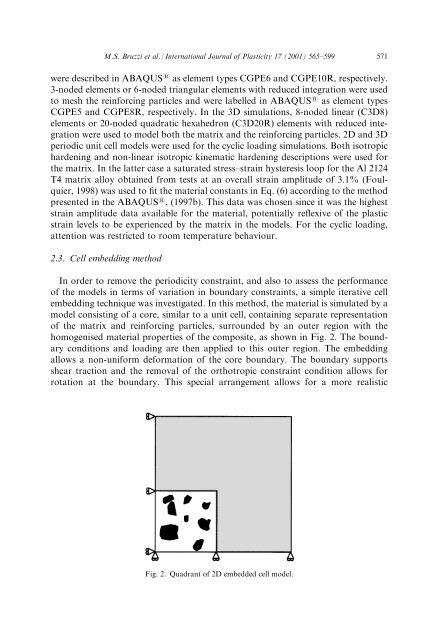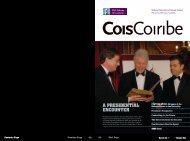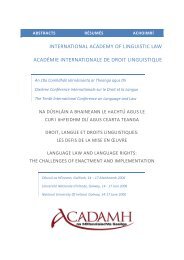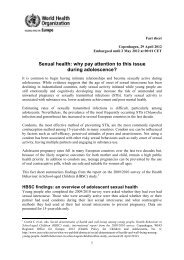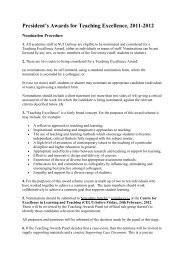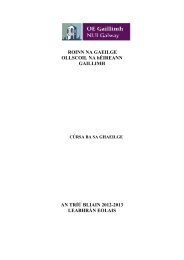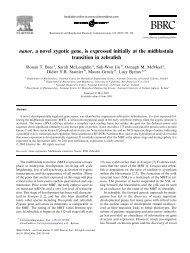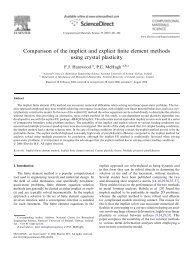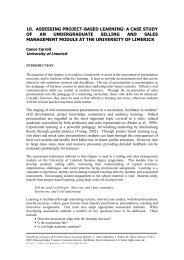Micromechanical modelling of the static and cyclic ... - ResearchGate
Micromechanical modelling of the static and cyclic ... - ResearchGate
Micromechanical modelling of the static and cyclic ... - ResearchGate
You also want an ePaper? Increase the reach of your titles
YUMPU automatically turns print PDFs into web optimized ePapers that Google loves.
M.S. Bruzzi et al. / International Journal <strong>of</strong> Plasticity 17 (2001) 565±599 571<br />
were described in ABAQUS 1 as element types CGPE6 <strong>and</strong> CGPE10R, respectively.<br />
3-noded elements or 6-noded triangular elements with reduced integration were used<br />
to mesh <strong>the</strong> reinforcing particles <strong>and</strong> were labelled in ABAQUS 1 as element types<br />
CGPE5 <strong>and</strong> CGPE8R, respectively. In <strong>the</strong> 3D simulations, 8-noded linear (C3D8)<br />
elements or 20-noded quadratic hexahedron (C3D20R) elements with reduced integration<br />
were used to model both <strong>the</strong> matrix <strong>and</strong> <strong>the</strong> reinforcing particles. 2D <strong>and</strong> 3D<br />
periodic unit cell models were used for <strong>the</strong> <strong>cyclic</strong> loading simulations. Both isotropic<br />
hardening <strong>and</strong> non-linear isotropic kinematic hardening descriptions were used for<br />
<strong>the</strong> matrix. In <strong>the</strong> latter case a saturated stress±strain hysteresis loop for <strong>the</strong> Al 2124<br />
T4 matrix alloy obtained from tests at an overall strain amplitude <strong>of</strong> 3.1% (Foulquier,<br />
1998) was used to ®t <strong>the</strong> material constants in Eq. (6) according to <strong>the</strong> method<br />
presented in <strong>the</strong> ABAQUS 1 , (1997b). This data was chosen since it was <strong>the</strong> highest<br />
strain amplitude data available for <strong>the</strong> material, potentially re¯exive <strong>of</strong> <strong>the</strong> plastic<br />
strain levels to be experienced by <strong>the</strong> matrix in <strong>the</strong> models. For <strong>the</strong> <strong>cyclic</strong> loading,<br />
attention was restricted to room temperature behaviour.<br />
2.3. Cell embedding method<br />
In order to remove <strong>the</strong> periodicity constraint, <strong>and</strong> also to assess <strong>the</strong> performance<br />
<strong>of</strong> <strong>the</strong> models in terms <strong>of</strong> variation in boundary constraints, a simple iterative cell<br />
embedding technique was investigated. In this method, <strong>the</strong> material is simulated by a<br />
model consisting <strong>of</strong> a core, similar to a unit cell, containing separate representation<br />
<strong>of</strong> <strong>the</strong> matrix <strong>and</strong> reinforcing particles, surrounded by an outer region with <strong>the</strong><br />
homogenised material properties <strong>of</strong> <strong>the</strong> composite, as shown in Fig. 2. The boundary<br />
conditions <strong>and</strong> loading are <strong>the</strong>n applied to this outer region. The embedding<br />
allows a non-uniform deformation <strong>of</strong> <strong>the</strong> core boundary. The boundary supports<br />
shear traction <strong>and</strong> <strong>the</strong> removal <strong>of</strong> <strong>the</strong> orthotropic constraint condition allows for<br />
rotation at <strong>the</strong> boundary. This special arrangement allows for a more realistic<br />
Fig. 2. Quadrant <strong>of</strong> 2D embedded cell model.


